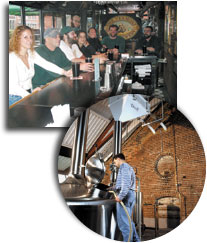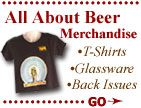
| ||||
| AAB Departments |
| ...Beer Features |
| ...Beer Talk |
| ...Pull Up A Stool! |
| ...What's Brewing |
| ...Beer Travelers |
| ...Stylistically Speaking |
| ...Beer & Food |
| ...Homebrewing |
| ...Collectibles |
| ...Marketplace |
| Beer Lovers' Resources |
| ...World Beer Festival |
| ...Brew Cruise Info |
| ...AAB Merchandise |
| ...AAB Bookstore |
| ...Beer Links |
| About the Magazine |
| ...Subscription Info |
| ...Retail the Magazine |
| ...Advertising Info |
| ...Contact AAB |

|
All About Beer Magazine
Volume 24 Number 1
Beer Travelers
 Brewing Tours
Brewing Tours
Frank Boon flashed a knowing smile last fall in Denver, as he sampled beers at the Great American Beer Festival. That’s not to say he loved everything he came across. Boon, who owns Belgium’s popular Brewery Boon, does not casually pass out compliments. Perhaps the brewer could have used fresher malt, he suggested of one beer. "Too much yeast still in the beer," he said of another.
What he tasted, though, reminded him that he knows something that many from the world’s traditional brewing centers continue to discount.
"Europeans will tell you Americans water down their beer, that they put ice in it," he said. "They don’t know what has occurred in the last 20 years. They need to come here and see how much as changed."
Boon was in Colorado to announce a joint project with New Belgium Brewing Co., located in Fort Collins. A visitor from the other side of the Atlantic, or an American, for that matter, couldn’t do much better than starting in Fort Collins to get a "big picture" look at the American brewing industry in four quick stops. You could easily walk from the first to second and the second to the third.
Stop 1: Coopersmith’s Pub & Brewery, one of the first brewpubs in Colorado. There are plenty of smaller breweries around the country, but the brew house here will seem tiny by the end of the day.
Stop 2: Odell Brewing Co., still small enough to be classified as a microbrewery but big enough to have a bottling line and cases of beer stacked to the ceiling. (Although bottling occurs long after beer is brewed, the line is a popular stop on any tour, and not only because it happens shortly before tasting begins.)
Stop 3: New Belgium Brewing, which dwarfed Odell’s even before completing a major addition this fall (installing a new 200-barrel brew house to go with its 100-barrel system). In just minutes, you can see brewers control the mashing process via computer, then walk among giant wooden vats, where funky microorganisms are doing something entirely different to beer than goes on in the massive stainless steel fermentation tanks two rooms over.
Stop 4: Anheuser-Busch, one of its five breweries open for tours. So big it makes New Belgium look like HO scale, though the Coors brewery in Golden is even bigger. (Coors is Colorado’s No. 1 unpaid tourist attraction and uses 3 million gallons of water per day.) The tour is first-rate, lasting about 75 minutes, and includes everything from the always-popular bottling lines to a historical hallway with early advertising to a trip to the barn where the Clydesdales live.
Brewery Touring
Fort Collins provides a unique opportunity to visit four diverse breweries only minutes apart, but most of us will settle for an occasional trip through a brewery. Most of the 1,500 or so US breweries offer tours, and each is a little different. Bigger breweries offer more frequent tours, often led by employees trained just to lead tours. At a smaller brewery, the folks who actually make the beer may also conduct the tours–and the time they have for that is limited.
The best way to make sure you get what you want from a tour is to call in advance for information about times tours are offered and what is included. Perhaps a buddy has told you about touring the Heineken brewery while in Europe and finishing with round after round of free beer. If you are going for free beer, you better make sure a (free) tasting session is included at the end of the tour.
We assembled this short list of breweries not with the idea that they necessarily have the "best" tours or beers. We tried for a mix of breweries and brewpubs, of large and small, and of styles brewed. If you visit them all, you’ll find interesting beer and interesting tours, but remember that Stone City isn’t the only brewery stitched together from found parts, nor is August Schell the only classic brewery with roots from before Prohibition.
And keep your eyes open. We were in McGuire’s Irish Pub & Brewery in Pensacola, FL, four years after the restaurant began brewing. Customers headed out the door, took a wrong turn and ended up in the brewing area. One asked about the equipment. "I’ve been coming here for years, and I never knew you made beer here," he said.
(Note: These breweries are listed from East to West.)
Vermont Pub & Brewery
Burlington, VT, 802-865-0500
Why: Owner Greg Noonan wrote the book (literally) on lager beer (New Brewing Lager Beer), but you’ll find the distinctively English-style ales you expect in the Northeast, including some on hand pump. The brewery is tucked out of sight, but worth touring on Wednesday evening or Saturday afternoon. Parts of it used to be a maple sap boiler, an ice cream maker and a pig-lot feeder. A local farmer collects the spent grain to feed to Black Angus cattle.
Beer to try: Vermont Smoked Porter.
High Point Wheat Beer Co.
Butler, NJ, 973-838-7400
Why: The brewery shares space with a dozen different businesses in the American Hard Rubber Mill, a sprawling historic building. Despite brewing on a 15-barrel Criveller system designed for English-style ales, founder Greg Zaccardi is dedicated to producing German-style beers, mostly Bavarian wheat beers. Visit for the Saturday tour and Zaccardi will tell you the story about the first time they made Winter Wheat–it was a triple decoction brew that took about 24 hours to mash.
Beer to try: Ramstein (all beers carry the name of the German city that is home to a large US Air Force base) Blonde, a true-to-style hefeweizen.
District Chophouse & Brewery
Washington, DC, 202-347-3434
Why: The Chophouse is part of the Rock Bottom chain, and as much upscale steakhouse as brewery. But that doesn’t mean that Jason Dorpinghaus makes the exact same beers as every other Rock Bottom brewery. The hefeweizen has a sharp clove element and little patronizing banana, for instance.
Beer to try: The bourbon stout on the hand pump. If that’s not available, try the oatmeal stout.
Great Lakes Brewing
Cleveland, OH, 216-771-4404
Why: The brewery is located in six buildings, three of which were originally constructed as stables and warehouse facilities for the Schlather Brewing Co., and the facility is just stunning (lots of large glistening tanks). But go to find out about the Zero Waste Initiatives. Local growers of organic produce use spent grain, yeast and hops from the brewery to produce vegetables and fruits, for instance, and the bottling line recycles water for final bottle rinsing.
Beer to try: It’s hard to resist the lagers at Great Lakes (because there are fewer great lagers around), but we have to go with the Edmund Fitzgerald Porter.
Boscos Nashville Brewing Co.
Nashville, TN, 615-385-0050
Why: Boscos also operates brewpubs in Little Rock and Memphis, but there is nothing chainlike about them–this is a neighborhood hangout with plenty of regulars. Brewer Fred Scheer is a fully trained German brewer with a master’s degree in brewing and malting from Doeman Academy. Yet his English-influenced ales (Boscos regularly serves cask-conditioned beer) show the same distinctively American bent as founding brewer Chuck Skypeck.
Beer to try: Boscos Bombay IPA, even though it is hard to resist the Flaming Stone Beer that Skypeck made (relatively) famous.
Stone City Brewing
Solon, IA, 319- 624-1360
Why: Only the tax determination tank, the heat exchanger and the bottling and kegging apparatuses are equipment originally meant for a brewery, and they were purchased used. Dairy tanks, bought through a dealer, are at the heart of the 16-barrel system. They are fired by burners acquired for as little at $1 each in local junkyards. The tasting room was put together by hand, and brewer Jeff Allen crafted its centerpiece–a beautiful stained-glass window of cattails.
Beer to try: Artist Colony Ale, named for painter Grant Wood’s old art colony in Stone City up the road.
August Schell
New Ulm, MN, 800-770-5020 (for tours)
Why: Schell’s history dates back to 1860, and it’s on display everywhere. The venerable brick brewery has its own gardens, complete with beer-friendly gnomes. A separate museum is jammed with Schell’s items from well before Prohibition. The brewery tours costs $2. There is no charge of admission to the museum.
Beer to try: Schell Bock. That gives you an excuse to visit for Bock Fest (March 1, 2003), an event complete with bonfires and the traditional Bock Hunt (for Bock cutouts hidden in the surrounding woods).
Red Rock Brewing Co.
Salt Lake City, UT, 801-521-7446
Why: Located in a converted warehouse, Red Rock looks like an awful lot of the other brewpubs opened in the mid-1990s. What makes it different is Utah’s restrictions on the alcohol content of its beer (3.2 percent by weight, about 4 percent by volume). Despite the laws, Utah breweries–including Red Rock–consistently produce beers that win medals against international competition, proving there’s more to making interesting beer than packing in extra alcohol.
Beer to try: Spalty Alt. As convincingly hoppy and smooth as a German alt should be.
Edgefield Manor
Troutdale, OR, 503-492-4636
Why: The showcase spot in the McMenamins empire of breweries and pubs across Oregon and Washington. Explore whatever you want on this 38-acre estate–the 23-barrel brewery, the distillery or the winery for starters–but be sure to take the tour that includes the funky murals and other artwork added to the poor farm turned into upscale lodge.
Beer to try: Terminator Stout.
Anderson Valley
Boonville, CA, 707-895-2337
Why: Founder Ken Allen likes to describe the brewery as one of the most international in the world, with equipment from the Dominican Republic, the former East Germany, Italy and Canada. Included are parts from two German breweries, but those copper vessels now make ales. The setting in Mendocino County is as pretty as the images on the labels, and there’s the opportunity to learn the 1800s lingo of Boontling (for instance: bahl hornin’ means good drinking).
Beer to try: Hop Ottin’ IPA. In Boontling, ottin’ means working hard.
----------------------------
Stan Hieronymus and Daria Labinsky are authors of The Beer Lover’s Guide to the USA (St. Martin’s Griffin).









